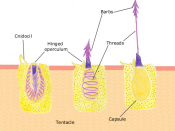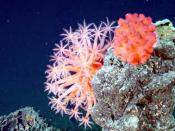Cnidarians (from the Greek knide meaning "nettle) represent the next higher level of organization of animals. They are radially symmetric and possess true tissues. However, like sponges, cnidarians have only two germ layers: ectoderm and endoderm. A middle layer, called mesoglea, is largely composed of a jellylike material. Hydra, jellyfish, sea anemones, and coral colonies belong to this diverse group. Members of this phylum, which consists of about 10 000 species, are found exclusively in aquatic ecosystems. The vast majority reside in marine environments and are common along Canada's three shorelines. Fewer than 50 species can be found in freshwater ecosystems, hydra being one of the most commonly occurring cnidarians in our lakes and ponds.
The evolutionary advances that the cnidarians demonstrate compared with the less complex sponges can be attributed to the development of true tissues. Cnidarians have specialized nerve, muscle, and digestive tissues. A nerve net encircles their body.
Some of the free-swimming forms have a ring of nerve cells around the bell, perhaps the primitive beginning of a central nervous system.
If hydra or sea anemones are touched, they respond by flattening out and pulling their tentacles inward. This type of movement indicates coordination of nerves and muscles, something not seen in the primitive sponge.
Cnidarians capture food by using specialized cells called cnidocytes, which contain sacs known as nematocysts. The nematocysts contain coiled, hollow, threadlike tubes that can shoot out rapidly and penetrate the skin of a prey or predator, some injecting toxic material. If sufficient nematocysts are triggered, the target can be paralyzed. Thousands of nematocysts can be found on a single tentacle.
Beach-goers may have painful memories of toxin-laden nematocysts. Thousands of the stinging cells can be found along the tentacles of jellyfish and floating bell-shaped colonies. The purple-colored medusa, or Vellela, occasionally floats...
![right|200px Hi people.de/haeckel/kunstformen/high/Tafel_049_text_2_200.html here])](https://s.writework.com/uploads/0/6837/right-200px-hi-people-haeckel-kunstformen-high-tafel-049-tex-thumb.jpg)

